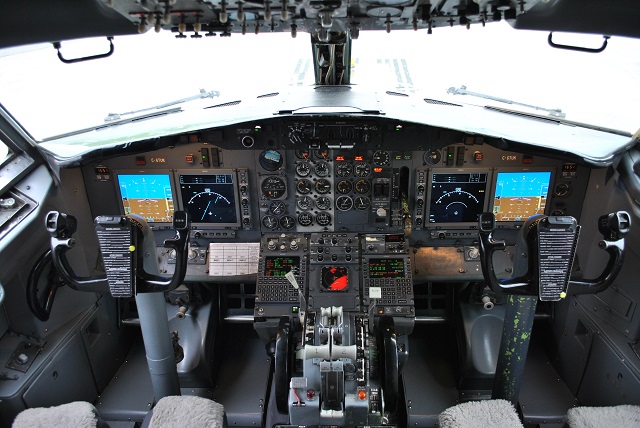As the worldwide fleet of Boeing 737-200s continues to dwindle, one Canadian operator sees a bright future in the aging twinjet.
Canada's Nolinor Aviation, which operates one of the world's largest 737-200 fleets, is investing C$10 million ($7.6 million) to equip 10 of the 40-year-old aircraft with modern avionics and glass displays.
In doing so, Nolinor seems likely to ensure that at least some 737-200s – a type Boeing first delivered in 1967 – remain flying for decades.
The aircraft's analog indicators and spinning gyroscopes will be replaced by Honeywell and Universal Avionics hardware and systems – a technological refresh enabling Nolinor's 737-200s to fly for another 25 years, the company's maintenance production manager Pierre Dore tells FlightGlobal.
"We are basically ripping the guts out and putting in brand-new, off-the-shelf stuff," he says.
Nolinor chose cockpit upgrades over aircraft replacements for a simple reason: 737-200s are approved to operate from gravel runways, Dore says.
"That's why we are still using the old -200s," he says. "Later-generation aircraft are not approved for gravel runway operations."
Based in Mirabel, near Montreal, Nolinor operates passenger and cargo charters, including flights to Canada's far northern regions for mining companies.
Its fleet includes seven 737-200s, one 737-300, four Convair 580s and Learjets, according to Flight Fleets Analyzer.
A Nolinor Boeing 737-200

Nolinor
Boeing produced about 1,100 Pratt & Whitney JT8D-powered 737-200s until 1988, when it delivered the last of the type.
The fleet has decreased significantly in size since, shrinking to about 900 in-service aircraft in 1998 and 354 in 2008, Flight Fleets Analyzer shows.
The fleet fell by one on 18 May when a 737-200 operated by Mexico City-based charter carrier Global Air, also called Damojh, crashed near Havana.
Today, just 77 737-200s remain active, operated by a hodgepodge of 44 carriers in Africa, Asia-Pacific, Latin America, the Middle East and North America.
Nolinor operates more 737-200s than any other airline – its seven examples account for a whopping 9% of the fleet, data shows.
Though they are between 34 and 44 years old, nearly all Nolinor's 737-200s have logged less than 50,000 cycles, meaning they can operate at least 20,000 more cycles prior to reaching life limits, says Dore.
Nolinor is upgrading the cockpits of the seven aircraft and another three that have not yet joined the fleet, he says. Mid-Canada Mod Center in Mississauga is performing the work.
One aircraft – registration C-GTUK– has already received its makeover, and a second aircraft will enter the shop in August, Dore says.
The first aircraft has been operating without issue since 31 May.
"Pilots are loving it," Dore says.
The aircraft are being fitted with four Universal Avionics' EFI-890R liquid crystal displays. Those displays link with two Honeywell Laseref V inertial navigation systems and two Universal UNS-1Lw flight management systems, says Nolinor.
The flightdeck of Nolinor 737-200 C-GTUK, the first aircraft to undergo cockpit upgrades

Nolinor
Though other operators have updated 737-200s with electronic flight instrument systems, Nolinor's aircraft are the first to receive Universal EFI-890R displays, Nore says.
The aircraft will also have automatic dependent surveillance-broadcast (out) systems – a requirement for operating in the USA starting in 2020.
In addition, the upgrades will give the 737-200s improved required navigation performance capability, enabling pilots to fly more direct routes, Dore says.
The old avionics, some made by long-defunct systems maker Sperry, are prone to maintenance problems, Dore says. Repairs have been difficult and spare parts have been hard to locate.
The new equipment will improve dispatch reliability and provide pilots with better situational awareness, says Dore, noting that the displays can provide overlays of weather, terrain and other information.
"Instead of troubleshooting steam gauges with hundreds of wires, we [can] hook laptops and chat with the aircraft and see what's wrong," he says.
Source: Cirium Dashboard



















